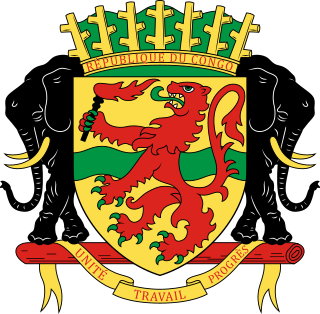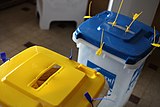A ballot is a device used to cast votes in an election and may be found as a piece of paper or a small ball used in voting. It was originally a small ball used to record decisions made by voters in Italy around the 16th century.
A voting machine is a machine used to record votes in an election without paper. The first voting machines were mechanical but it is increasingly more common to use electronic voting machines. Traditionally, a voting machine has been defined by its mechanism, and whether the system tallies votes at each voting location, or centrally. Voting machines should not be confused with tabulating machines, which count votes done by paper ballot.
Electoral fraud, sometimes referred to as election manipulation, voter fraud or vote rigging, involves illegal interference with the process of an election, either by increasing the vote share of a favored candidate, depressing the vote share of rival candidates, or both. It differs from but often goes hand-in-hand with voter suppression. What exactly constitutes electoral fraud varies from country to country.

The secret ballot, also known as the Australian ballot, is a voting method in which a voter's identity in an election or a referendum is anonymous. This forestalls attempts to influence the voter by intimidation, blackmailing, and potential vote buying. This system is one means of achieving the goal of political privacy.

A polling place is where voters cast their ballots in elections. The phrase polling station is also used in American English and British English, although polling place is the building and polling station is the specific room where voters cast their votes. A polling place can contain one or more polling stations. In Australian English, "polling place" is used.
Vote counting is the process of counting votes in an election. It can be done manually or by machines. In the United States, the compilation of election returns and validation of the outcome that forms the basis of the official results is called canvassing.
An absentee ballot is a vote cast by someone who is unable or unwilling to attend the official polling station to which the voter is normally allocated. Methods include voting at a different location, postal voting, proxy voting and online voting. Increasing the ease of access to absentee ballots is seen by many as one way to improve voter turnout through convenience voting, though some countries require that a valid reason, such as infirmity or travel, be given before a voter can participate in an absentee ballot. Early voting overlaps with absentee voting. Early voting includes votes cast before the official election day(s), by mail, online or in-person at voting centers which are open for the purpose. Some places call early in-person voting a form of "absentee" voting, since voters are absent from the polling place on election day.
During the 2004 United States elections, concerns were raised about various aspects of the voting process, including whether voting had been made accessible to all those entitled to vote, whether ineligible voters were registered, whether voters were registered multiple times, and whether the votes cast had been correctly counted. More controversial was the charge that these issues might have affected the reported outcome of the presidential election, in which the incumbent, Republican President George W. Bush, defeated the Democratic challenger, Senator John Kerry. Despite the existing controversies, Kerry conceded the election the following day on November 3.
Early voting, also called advance polling or pre-poll voting, is a convenience voting process by which voters in a public election can vote before a scheduled election day. Early voting can take place remotely, such as via postal voting, or in person, usually in designated early voting polling stations. The availability and time periods for early voting vary among jurisdictions and types of election. The goals of early voting are usually to increase voter participation, relieve congestion at polling stations on election day, and avoid possible discrimination against people with work and travel schedules that may effectively prohibit them from getting to the polls during the hours provided in a single election day.
Elections in South Korea are held on a national level to select the President and the National Assembly. Local elections are held every four years to elect governors, metropolitan mayors, municipal mayors, and provincial and municipal legislatures.

The Ballot Act 1872 was an Act of the Parliament of the United Kingdom that introduced the requirement for parliamentary and local government elections in the United Kingdom to be held by secret ballot. The act abolished the traditional hustings system of nomination and election in Britain.

General elections in Singapore must be held within three months after five years have elapsed from the date of the first sitting of a particular Parliament of Singapore, as per the Constitution. However, Parliament can also be dissolved and a general election called at the behest of the Prime Minister before the five-year period elapses. The number of constituencies or electoral divisions is not permanently fixed by law, but is declared by the Prime Minister prior to each general election pursuant to the Parliamentary Elections Act, which governs the conduct of elections to Parliament, taking into account recommendations of the Electoral Boundaries Review Committee.

The Mexican general election of July 2, 2006, was the most hotly contested election in Mexican history and as such, the results were controversial. According to the Federal Electoral Institute (IFE), the initial "Quick Count" determined the race was too close to call, and when the "Official Count" was complete, Felipe Calderón of the right-of-center National Action Party (PAN) had won by a difference of 243,934 votes. The runner-up, Andrés Manuel López Obrador of the left-of-center Coalition for the Good of All, immediately challenged the results and led massive marches, protests, and acts of civil resistance in Mexico City. On August 9, while protests continued to expand, a partial recount was undertaken by election officials after being ordered to do so by the country's Federal Electoral Tribunal. The tribunal ordered the recount of the polling stations that were ruled to have evidence of irregularities, which were about nine percent of the total.
End-to-end auditable or end-to-end voter verifiable (E2E) systems are voting systems with stringent integrity properties and strong tamper resistance. E2E systems often employ cryptographic methods to craft receipts that allow voters to verify that their votes were counted as cast, without revealing which candidates were voted for. As such, these systems are sometimes referred to as receipt-based systems.
An optical scan voting system is an electronic voting system and uses an optical scanner to read marked paper ballots and tally the results.

There are five types of elections in the United Kingdom: elections to the House of Commons of the United Kingdom, elections to devolved parliaments and assemblies, local elections, mayoral elections, and Police and Crime Commissioner elections. Within each of those categories, there may also be by-elections. Elections are held on Election Day, which is conventionally a Thursday, and under the provisions of the Dissolution and Calling of Parliament Act 2022 the timing of general elections can be held at the discretion of the prime minister during any five-year period. All other types of elections are held after fixed periods, though early elections to the devolved assemblies and parliaments can occur in certain situations. The five electoral systems used are: the single member plurality system (first-past-the-post), the multi-member plurality, the single transferable vote, the additional member system, and the supplementary vote.
The 1872 Pontefract by-election was fought on 15 August 1872. The ministerial by-election was fought due to the incumbent Liberal MP, Hugh Childers, becoming Chancellor of the Duchy of Lancaster and Paymaster General. It was retained by Childers.

Congo’s electoral law was approved in 2001 and amended in 2007, 2012, 2014 and 2016. It aims to provide the conditions for a democratic and transparent electoral system, from campaigning and media access through voter registration, vote counting and certification.

An election audit is any review conducted after polls close for the purpose of determining whether the votes were counted accurately or whether proper procedures were followed, or both.
Absentee voting in the United Kingdom is allowed by proxy or post for any elector.























